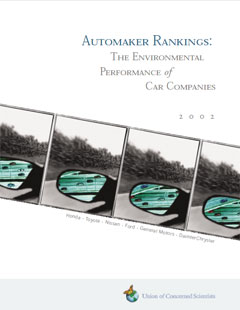Just six companies are responsible for over 90 percent of emissions from the United State's most polluting product, the automobile. These manufacturers rank among the largest companies in the world, and lie at the intersection of mounting concerns over corporate responsibility and environmental protection. This report relies on government data to quantitatively analyze which automakers are the greenest, moving beyond board room statements to evaluate what each of the Big Six automakers is actually selling in its showrooms.
We focus on the cars, SUVs, minivans, and pickups sold by the six largest companies in the US market, analyzing their emissions of smog-forming pollutants and global warming gases. Based on the relative emissions of the average new vehicle sold by each company, we then rank the automakers from cleanest to dirtiest, placing equal weight on their contribution to smog and global warming.
UCS first undertook this study two years ago, analyzing emissions for model year 1998 (MY98) vehicles. This report evaluates vehicles sold in 2001 (MY01), the most recent model year for which data are publicly available, as well as model year 2000 (MY00) for comparison purposes. We found that the pollution ranking of the automakers has remained relatively constant since MY98, with one notable exception: Although still dirtier than the average, Ford has overtaken General Motors as the greenest of the Big Three as a result of its voluntary commitment to build trucks with lower smog-forming emissions.
Our quantitative comparison of emissions indicates that not all automakers are equal when it comes to the environmental performance of their products. The average new vehicle sold by Honda in MY01, for example, emitted 21 percent less global warming gases and 31 percent less smog-forming pollution than the average for the Big Six automakers. In contrast, DaimlerChrysler's average MY01 vehicle was 9 to 10 percent dirtier.
Technology differences between cars and trucks are an important factor in our rankings. Current environmental regulations permit trucks to pollute more than cars. As a result, the average MY01 truck emitted 2.4 times more smog-forming pollution and 1.4 times more global warming gases than the average MY01 car. Companies with sales dominated by trucks are generally dirtier; however, there are important exceptions. Both Nissan and Ford are ranked above GM in our analysis —despite the fact that they sell more trucks than cars —because their trucks have lower smog-forming emissions. High truck sales do not have to be an environmental liability. Improving Pollution Performance
Ample technology exists to cost-effectively reduce emissions of smog-forming pollutants and global warming gases. Future regulations will require all passenger vehicles to meet the same smog-forming emissions standards by MY09, but there are no significant engineering barriers to accomplishing this sooner. Several recent studies have further demonstrated that off-the-shelf technologies can reduce global warming pollution from both cars and trucks while saving consumers money at the pump. Incorporating these technologies into their product plans will yield much needed improvements in public health and environmental quality. Automaker Action
Decisions about the environmental impact of US cars and trucks are concentrated in the hands of just a few corporations. Ford's commitment to cleaner trucks, and its resulting rise in our ranking, is proof positive that automakers can improve their pollution performance through voluntary action, although continued leadership is needed to maintain their edge. Unfortunately, Ford's more visible commitment to boost SUV fuel economy will mean little if these gains continued to be swamped by increasing sales of inefficient pickups elsewhere in their fleet.
Companies that continue to lower emissions of smog and global warming gases will climb the green rankings. For example, if Ford committed to not only make its trucks cleaner than required by law, but actually as clean as its cars, it would reach second place in our ranking. If it further extended its SUV commitment to all its trucks and achieved a 25 percent fuel economy improvement, it would be tied with Honda for first place.




